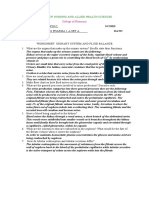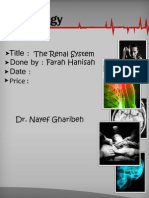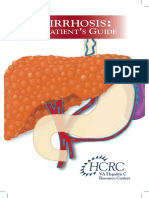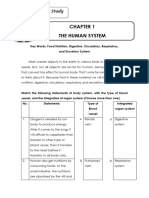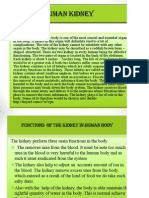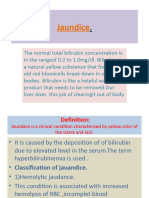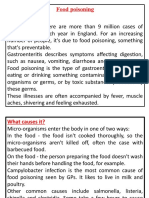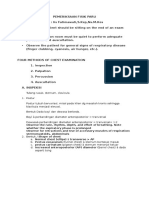0 ratings0% found this document useful (0 votes)
45 viewsCirrhosis of The Liver Nursing Care Management Symptoms NCLEX
Cirrhosis of The Liver Nursing Care Management Symptoms NCLEX
Uploaded by
ParallelCirrhosis is a liver disease where the liver cells become severely damaged and scarred, preventing them from functioning properly. Common causes include viral hepatitis, heavy alcohol use, obesity, and problems with the bile ducts. The liver normally filters and detoxifies blood from the digestive organs, metabolizes nutrients, and produces important proteins and bile. In cirrhosis, the damaged liver cells can no longer perform these vital roles, leading to complications like jaundice, hypoglycemia, and toxic buildup of ammonia in the blood.
Copyright:
© All Rights Reserved
Available Formats
Download as DOCX, PDF, TXT or read online from Scribd
Cirrhosis of The Liver Nursing Care Management Symptoms NCLEX
Cirrhosis of The Liver Nursing Care Management Symptoms NCLEX
Uploaded by
Parallel0 ratings0% found this document useful (0 votes)
45 views10 pagesCirrhosis is a liver disease where the liver cells become severely damaged and scarred, preventing them from functioning properly. Common causes include viral hepatitis, heavy alcohol use, obesity, and problems with the bile ducts. The liver normally filters and detoxifies blood from the digestive organs, metabolizes nutrients, and produces important proteins and bile. In cirrhosis, the damaged liver cells can no longer perform these vital roles, leading to complications like jaundice, hypoglycemia, and toxic buildup of ammonia in the blood.
Original Title
Cirrhosis of the Liver Nursing Care Management Symptoms NCLEX
Copyright
© © All Rights Reserved
Available Formats
DOCX, PDF, TXT or read online from Scribd
Share this document
Did you find this document useful?
Is this content inappropriate?
Cirrhosis is a liver disease where the liver cells become severely damaged and scarred, preventing them from functioning properly. Common causes include viral hepatitis, heavy alcohol use, obesity, and problems with the bile ducts. The liver normally filters and detoxifies blood from the digestive organs, metabolizes nutrients, and produces important proteins and bile. In cirrhosis, the damaged liver cells can no longer perform these vital roles, leading to complications like jaundice, hypoglycemia, and toxic buildup of ammonia in the blood.
Copyright:
© All Rights Reserved
Available Formats
Download as DOCX, PDF, TXT or read online from Scribd
Download as docx, pdf, or txt
0 ratings0% found this document useful (0 votes)
45 views10 pagesCirrhosis of The Liver Nursing Care Management Symptoms NCLEX
Cirrhosis of The Liver Nursing Care Management Symptoms NCLEX
Uploaded by
ParallelCirrhosis is a liver disease where the liver cells become severely damaged and scarred, preventing them from functioning properly. Common causes include viral hepatitis, heavy alcohol use, obesity, and problems with the bile ducts. The liver normally filters and detoxifies blood from the digestive organs, metabolizes nutrients, and produces important proteins and bile. In cirrhosis, the damaged liver cells can no longer perform these vital roles, leading to complications like jaundice, hypoglycemia, and toxic buildup of ammonia in the blood.
Copyright:
© All Rights Reserved
Available Formats
Download as DOCX, PDF, TXT or read online from Scribd
Download as docx, pdf, or txt
You are on page 1of 10
This is sarah with registerednessrn.
com and in this video i'm going to be going over cirrhosis
and this video is part of an nclex review series over the gastrointestinal system and as always
at the end of this video don't forget to take the free quiz i will test you on this condition so
let's get started so what is cirrhosis cirrhosis
Is a liver disease where the liver cells become so severely damaged that they become
replaced with this fibrosis tissue so your liver cells start to become scarred so whenever you
think of cirrhosis think of scarring you have major liver scarring which is preventing these
cells from doing their job in the liver now what can cause cirrhosis well a couple of things
Number one a viral infection like from hepatitis c or b and what happens that virus gets in
those liver cells attacks them and they no longer function and do their jobs so the patient can
develop scarring of the liver another cause is heavy alcohol consumption and these two top
ones are the most common causes here in the u.s
Of cirrhosis then another cause is increased fat collection in the liver and this causes actually
on the rise due to increased number of people with obesity also patients who do not manage
their cholesterol they have long-term hyperlipidemia and diabetes can lead to this condition
as well also problems with the bile duct and why is that
Okay well really your liver and your gallbladder work together your liver produces the bile
which goes down through the common bile duct and hangs out in the gallbladder until you
need that bile to help digest the fats in your food well if you get a stone in here that can cause
that bile not to drain down properly which can backflow into the liver and damage those
Cells hence over time leading to cirrhosis and of course anything that is like an autoimmune
condition that attacks those hepatocytes within the liver now let's take a look at the role of our
liver because in order to understand those complications that you're going to see in a patient
with cirrhosis along with our nursing interventions the whole rationale while
We're doing what we're doing we have to understand the basic function of our liver okay so
what does our liver do our liver is a super important organ i know i say that about every
organ but it's really really true about the liver because in a nutshell what our liver is doing is
it's taking that blood that it's receiving because what's cool about the liver is that it
Receives its blood supply from two sources which we're going to go over here in a second
and it's going to take that blood and it's going to filter it and it's going to do several things of
the to the substances found in that blood it's going to metabolize many of those substances it's
going to detoxify remove some of those substances from the blood that we
Don't need like drugs we've taken or things that have just built up in the body that we don't
need it's going to store some of those substances and then it's going to produce some really
important substances like bile proteins that play a role in clotting and like albumin and things
like that so it's super super important
Now how does it do that well it does that through its blood supply so let's talk about those
two routes it receives its blood okay the first one that i really want you to commit to memory
is called the hepatic portal vein that's this in blue because this is a big complication that is
going to happen in cirrhosis called portal hypertension
So you have this hepatic portal vein and it is receiving blood from your organs that play a
role in digestion so the blood that is shooting through that hepatic portal vein is really rich in
nutrients but it's really poor in oxygen so in order to really for your liver to survive it needs
some oxygenated blood
Which is going to come through that hepatic artery and the hepatic artery has came off from
the aorta and remember the aorta has just came off from the heart and has received that nice
fresh oxygenated blood and it's going through the body now what are those organs connected
to the hepatic portal vein which you want to remember because whenever we develop portal
hypertension
Some of these organs are going to be affected so we have the pancreas coming off from the
hepatic portal vein our stomach our spleen very important and our small and large intestines
and it's sanding because you just ate food and you have all those cells that have taken the
nutrients gathered it from your food and it's going to take it to the liver so the liver can do
what it needs
With it now as all this blood enters the liver through the hepatic artery and the hepatic vein
it's eventually going to mix together and make its way back through the heart once it's been
filtered but how is it filtered what's doing this well in your liver are these little functional
units called hepatic lobules and they are the areas that contain the liver
Cells that do all the hard work to filter the blood i like to compare it to whenever we were
talking about the kidney remember in each kidney you have the nephrons and there's millions
of those little nephrons and the nephrons had these little systems that took and remove this
filtrate here put this here and in the end produce urine and maintain homeostasis in our
Body well in a sense the liver is doing a little bit of the same but it doesn't produce urine of
course so whenever you look at the lobule if you took it and sliced it like this you could see
these little areas of where the hepatic portal veins coming in the artery and the common bile
duct and how it's all flowing into that central vein which is going to go back to the heart
So if you cut it in half like i said you will find this hexagon shape and within each corner of
the hexagon shape you have in green the common bile duct which is going to receive bile
from the hepatocytes because in this white area which i represented in blue here are your
hepatocytes and your hepatocytes are really what does majority of the job in the liver with
metabolizing storing
And producing everything like that and they're going to send the bile that they produce
through that common bile duct which is going to go eventually down to the gallbladder and
be stored whenever you need it to help digest fats and it's going to be squirted down into the
duodenum and remember bile plays a role in this and us absorbing fats and those fat
Soluble vitamins then here you have the hepatic artery and the hepatic portal vein and
together this is called the portal triad and the blood is going to flow from the hepatic artery in
the hepatic portal vein into the sinusoid which is represented in this like blue area that's going
to flow down there and eventually drain into the central vein and go back to the
Heart well in this sinusoid is this really neat cell called the cook for cell and it's a type of
microphage and it is here in purple and this macrophage what do they do they like to clean up
the area and its job is going to be removing debris removing bacteria and most important of
all that i want you to remember is removing those old red blood cells because the cook fur
and the padasides
In a or a team in how they turn unconjugated bilirubin into conjugated bilirubin which is
really a big thing in cirrhosis whenever we're talking about jaundice so remember that okay
now let's analyze what it does and hit the highlights of what it metabolizes detoxify stores
and produces because it ties in to our signs and symptoms nursing interventions and
everything okay
So metabolizing big thing that your liver metabolizes is glucose because it just received all
this blood that is very rich in glucose from those digestion organs and what it's going to do is
it's going to take those excessive amounts of glucose in the blood and it's going to synthesize
it and store it as glycogen for later in case we need it so
Think back to whenever a patient's liver isn't working in cirrhosis what's going to happen
well the liver isn't going to take that extra glucose in the blood because those cells aren't
working what's going to happen to our blood sugars we're gonna have hyperglycemia okay so
they're gonna be struggling with that in really late stages of cirrhosis another thing that the
liver does with
This is it converts glycogen to glucose so when a patient is sick or whatever they need their
blood sugar to be go up the liver is going to help play a role in turning that glycogen into
glucose which is going to in turn increase our blood sugar but if the patient has cirrhosis say
they're sick they're not eating they're not going to have this ability
To increase that blood sugar because this right here isn't happening so they're also going to
struggle with hypoglycemia and that's why a lot of times people with cirrhosis may be termed
hepatic diabetes they develop diabetic type symptoms with cirrhosis and that is the reasoning
behind it because the liver is not metabolizing and messing with the glucose and the
Glycogen like it should now let's talk about how it metabolizes lipids and specifically
proteins i want to hit on the proteins okay proteins what is the byproduct of protein
breakdown it is ammonia well ammonia is really toxic to our body and our liver knows that
so it will take that ammonia and convert it into urea which is a little less toxic and the kidneys
can deal with that
Urea and the kidneys will take it and excrete it out and get rid of it so the liver helps do that
but if we have cirrhosis this process is not taking place and instead we're not going to have
the conversion to urea we're going to be keeping the ammonia and this causes toxic effects on
the brain which is why you will see in severe cases of cirrhosis
So those neurological changes which we're going to talk about in our signs and symptoms so
keep that in mind now let's talk about storage liver is a great place for storage it stores our
vitamins like b12 vitamin a c e d and k in a second we're going to learn how those hot asides
which i talked about a little bit produce bile well bile plays a role in us absorbing fats
And absorbing those fat soluble vitamins well if we're not producing enough bile to do the
job we're not going to be absorbing these fat soluble vitamins which is going to be very toxic
for us because vitamin d what does vitamin d do it plays a role in allowing us to absorb
calcium if we can't absorb calcium what happens to our bone health it decreases so patients
with cirrhosis can experience
Bone fractures vitamin k that plays a huge role in the whole clotting process we don't have
enough of that we can't even absorb it because our bile is not there and then we can't even
store it for further use so we're going to have issues with clotting and here in a second you're
going to see how the proteins that the liver produce play a role in clotting as well
Along with the liver also stores our iron and of course of course the glycogen now the liver
also plays a role in digestion and we just learned that the hepatocytes make bile and what bile
does well in the bile is a substance called bilirubin now how in the world did the bilirubin get
in the bile well remember those cook for cells we were talking about that are found
In the hepatic lobule well they removed all red blood cells and they break down lysis those
red blood cells and break down that hemoglobin into groups a heme and a globin group now
your hepatocytes will take the heme that was broken down from the hemoglobin and will
metabolize it into iron and bilirubin so what we're interested in
Is the bilirubin so the bilirubin after it's metabolized from the hepatocyte will go down into
that common bile duct mix with the bile and it will leave the body in the stool so that's why
the stool is brown because bilirubin is like this yellowish brownish color and gives the stool
its color so that's why whenever you look at the stool in patients with
Jaundice their stools are going to be clay colored they're not going to be that normal brown
now why is that let's talk about that okay in cirrhosis those hepatocytes are damaged so
they're not able to take this bilirubin like it should and put it into the bile instead it's going to
leak and it's going to leak down into our
Blood system and go into the blood and we shouldn't have all this bilirubin in our blood
which is why we can check bilirubin levels and that can help in diagnosing liver disease so
get bilirubin in the blood which is this yellowish brown color that is going to leak into our
skin which is why we're going to see jaundice so jaundice you can see the yellowing of
The sclera of the eyes the whites of the eyes this skin can get yellow i've seen patients it's like
a pumpkin looking hue to their skin and their mucous membranes and of course there's no
bilirubin in the stool because it's all hanging out in the blood so that is why you're going to
have those clay colored stools another thing is that our liver produces our blood plasma
proteins
Which plays a role in our overall health one important protein that i want to talk about is
albumin and we've talked a lot about albumin and what albumin does is it maintains the
oncotic pressure within our capillaries so water likes to stay with albumin so that keeps the
water inside the capillary than going into that interstitial tissue well in cirrhosis
You don't have any albumin hardly so what's happening is that there's no water to cling to the
albumin so the water just flows out of the capillary into that interstitial tissue tissue which is
why you're going to be seeing the societies in that patient the swollen abdomen and swelling
in the lower legs also it makes fibrogen and prothrombin
And these are our proteins that play a role in our clotting abilities so not producing those
what's going to happen this patient is at major risk for bleeding out not being able to clot
another thing our liver does is it detoxify so detoxification so whenever we take medications
what it does is it helps make those medications less harmful to our body so it's really
Important the patient has good liver function when taking medicines and they have really bad
liver disease and long-term cirrhosis they want to avoid drugs like sedatives especially
tylenol and things like that also want to re remove drinking any alcohol because the liver
removes alcohol makes it less toxic to your body and if you don't have
That ability you drink alcohol you're going to get very major toxic effects also a very
interesting thing that our liver does is that it helps remove hormones in our body that are
produced by our glands and one hormone i want to hit on is estrogen okay so what will
happen is that you have the hormones that naturally go through your body and your
Liver is going to remove them and take them out and keep this nice balance well say in
cirrhosis patient has this the body is not going to metabolize estrogen so if we're not
metabolizing estrogen and getting rid of it what's going to happen it's just going to hang out
in the body so those levels are going to increase even more and this is not good
Especially in our male patients because they can start experiencing gynecomastia which is
enlargement of the breast tissue in males and this is why you're also going to see these other
signs and symptoms because the estrogen levels can be high such as the itchy red palms of
the hands along with also seeing what's called spider
Angiomas and this is these areas hence why they're called a spider that you will see on the
skin looks like breaks in the skin and you have the area in the center that's red and it just
branches out and these can be on the chest and on the arms and if you have a patient with
cirrhosis look at their skin you may see that and that's from those increased estrogen levels
now let's look
At the complications that can happen with cirrhosis okay we just hit on the anatomy and the
role of the liver okay so what are some complications because remember we have scarred
tissue in the liver those cells are no longer working it's being replaced with all this fibrosis
tissue so one thing that can happen is called
Portal hypertension now remember that hepatic portal vein what happens is that it becomes
narrowed due to all the scar tissue in the liver so what's going to happen you're going to have
restriction of blood flow to the liver itself and the pressure is going to increase in that hepatic
portal vein to all those organs that were connected to the portal vein and you're going to
Have some major problems which is going to lead to all this other stuff you can see an
enlarged spleen in these patients with cirrhosis proper term is splenomegaly now what does
our spleen do let's think back to that our spleen normally stores our platelets and our white
blood cells well if you have all this increased pressure
In this portal vein going to this spleen what's going to happen nothing's going to really flow
out of there so those platelets and those white blood cells are going to get stuck in there and
what's like what's going to happen to our platelet count it's going to decrease what's going to
happen to our white blood cell count it's going to decrease so we're going to be at risk for
bleeding out because we don't have platelets
Readily accessible to us and our immune system is going to suffer because our white blood
cells help us fight infection another thing these patients can develop is called esophageal
varices and this can also they can also develop gastric varices and this is where you get these
engorged dilated vessels and what's happened is that increased pressure in that hepatic portal
vein is just really
Enlarging these vessels and over time they can become weak and they can rupture and if this
happens this is an emergency it's life-threatening because why is it life-threatening well
they're going to bleed out in this location the esophagus or the gastric area well we don't have
our clotting ability
To clot we have low platelets because of what's going on up here we also have decreased
vitamin k because we're not really absorbing it and we're not storing it in our liver because
our liver is not working it's scarred and we have decreased clotting factors so it's a double
whammy on these patients and some more complications that can be seen are of course fluid
volume
Overload you can see swelling in the lower parts of the legs at the ankles and the feet and in
really severe cases in the abdomen and we call this ascites this is where the abdomen will be
really swollen out and it's full of fluid and with this the patient is at a high risk for developing
infection because think about it the gut normally has all this bacteria but it's okay if it stays
there but if we have
All this fluid surrounding all that gut tissue with that bacteria the patient's at risk for
developing an infection plus they probably already have a compromised immune system due
to the low white blood cell count that we talked about with the whole splinomegaly so they're
at risk for that and this is due to that venous congestion coming in
From the hepatic portal vein because it's narrowed and it's increasing all that pressure along
with that low albumin level the liver is not really producing this albumin albumin maintains
our oncotic pressure so we don't have fluid just flowing out into that interstitial tissue so that's
why you're getting the swelling there also jaundice which we really hit on when we talked
about the function
Of the liver with the cook fur and hepatocyte you can see the yellowing of the skin and the
clay colored stools they can also in really severe stages experience renal failure in a condition
called hepatorenal syndrome and really cirrhosis in those late stages is going to be can cause
multi-organ failure it's going to affect everything your brain and the renal system
Another condition that you really want to remember is it can cause what's called hepatic
encephalopathy and why is this this is because the liver is unable to detoxify itself the blood
from things that normally could so those toxins like ammonia because remember that's the
bipod product of protein breakdown and the liver will take that amount and turn it into urea
and get rid
Of it well it can't do that so ammonium's going to collect in our brain along with other toxins
and what's going to happen to your patient their mental status is going to change so you really
need to monitor their mental mental status be asking them those questions how are they
responding to you it can lead to a coma another thing it can cause
From the collection of ammonium the ketones and everything in the system is a condition
called asterixis and i would remember that and how you elicit this response is to have the
patient hold up their hands like this and you will see this involuntary flapping of the hands
like this and that's why sometimes people may re refer to it as hand flapping and you will see
that
Another thing this is seen in late stages of cirrhosis very in very severe it's called hepatic fetor
or fetor hepaticus and this is where the patient's breath will have this pungent musty sweet
smell to it and it's from where again the ammonium and the ketones have collected in the
blood and what's happening is that you have all this uh portal shunting of this blood and
It's affecting the heart and it's causing from all those toxins to build up as they pass through
the lungs it enters into the lungs and as the patient breathes out and talks it will mix in with
that air that they're breathing out and you can actually smell that and again that's a really late
sign the patient can also experience liver cancer along with
Bone fractures and that was again because of our low vitamin d it's not being stored and
vitamin d plays a role in how we absorb our calcium so they can have that along with
diabetes and that's tied back to the way that our body stores glycogen and then breaks
synthesizes the glycogen and turns it into glucose so we can manage our blood sugars now
let's sum up everything that
We have learned and look at the signs and symptoms that this patient may have with cirrhosis
now in the early stages when a patient has cirrhosis they may be unaware that they have
cirrhosis because they really don't have signs and symptoms until it gets really severe in the
long term and whenever they do it as you've seen it affects everything so they're going to
have lots
Of signs and symptoms so to help us remember the signs and symptoms let's remember the
mnemonic the liver is scarred because this is what is going on our liver scarred and that's why
we're having all these problems okay t for tremors that was that asterixis the flapping of the
hands h hepatic fator that was that musty smelly pungent breath light sign e for eye and
Skin yellowing the jaundice that you're gonna see from the bilirubin hanging out in the blood
it should be in the stool but hepatocytes aren't working so it's in the blood and it's causing
everything to become discolored l for loss of appetite why would they have a loss of appetite
well their spleen is probably going to be enlarged the spleen and the stomach or in close
proximity
It's going to push on that stomach causing the patient to feel full plus just all the extra fluid on
the stomach if they have ascites can cause that as well i for increased bilirubin and
ammonium levels that that's some blood test the physician can order look in that bilirubin
level and the ammonium level which we'll talk about a little bit later because we can give a
medication
To help decrease that v for varices those esophageal or gastric varices and remember if they
rupture that is in a medical emergency e for edema in the legs r for reduced platelets which if
you have reduced platelets what's going to happen increased risk of bleeding out and reduce
white blood cells have that increased risk of infection eye for itchy skin that's buildup of the
toxins in the
Blood s spider angiomas and that's from that increased estrogen s for splenomegaly c for
confusion slash coma increase toxins in the body a for a cities again that's because of
decreased albumin and that venous congestion r for redness on the palms that's from the
increased estrogen as well
R for renal failure e for enlarged breast and men again from increased estrogen because your
liver is not metabolizing and removing the estrogen from the body so it's hanging out and
then the last part of the mnemonic d deficient on vitamins like vitamin b12 a c d e and k now
let's look at how is this condition diagnosed the nursing interventions we're going to do for
this patient and the treatments
Okay a lot of times cirrhosis is diagnosed through a liver biopsy they can have other imaging
like an ultrasound other tests to assess the structure of the liver also the physician can order
blood tests to look at things that can be tied in with cirrhosis like those liver enzymes
specifically albumin look at the platelet levels are they low
The ptinr the clotting levels vitamin levels the bilirubin along with seeing does this patient
have hepatitis b or c because remember that's one of the causes of this condition now let's
switch gears and look at our nursing interventions okay whenever we're looking looking at
nursing interventions let's look at our problems because our problems tie in for what we're
going
To do with this patient and remember with cirrhosis this is like a multi-organ involved
condition and there's a lot of things going on so one thing they're going to be having glucose
issues probably going to have what looks like diabetes hepatic diabetes so we want to
monitor them for high blood sugars and low blood sugars because their liver can't store
That glycogen and then take it out turn it into glucose and help manage glucose stability so
we need to monitor them for that there are risks for bleeding because they're not making
those proteins that help with clotting so we might want to monitor their ptinr and from our
standpoint we want to limit invasive procedures like starting all those ivs if we do have to
start an iv
Or do anything that punctures the skin hold pressure for at least five minutes or more because
our wrists were bleeding out with mouth care the gums want to use a soft toothbrush so we
don't nick a gum and just keeps bleeding and checking their stool for blood and looking at the
skin do they have petechiae which is where they're having bleeding
Underneath the skin also tying in with this those varices they can have esophageal or gastric
type varices and they're at risk for bleeding because these can rupture so we want to make
sure that they haven't ruptured look at those vital signs are they hypotensive tachycardic are
they throwing up blood are they have a lot of blood in their stool we want to monitor for that
and we want to
Limit and educate them about activities to help decrease the risk of rupturing them well if the
patient has esophageal varices they could cough excessive coughing can make one of those
ruptures vomiting consuming alcohol or constipation that increased pressure can pop one of
those vessels open next they are having toxin buildup so from our standpoint we
Want to monitor that mental status very closely are they deteriorating they're getting worse
because more could be collecting in the brain checking their reflexes checking them for that
hand flapping the asterixis also monitoring that ammonium level ordered on this patient and
if they do have a high emotion level a lot of times physicians order lacto-lows through a po
Or an enema route you're going to be assessing that jaundice and because that's remember
where that bilirubin is leaking into the blood so they're going to have the yellowing of the
sclera of the eyes of the skin and also they their urine can be really dark colored from where
it's leaking into the urine as well so let look at that now let's talk about diet because it's
important if you have hepatic encephalopathy going on
Where you do have this toxin buildup with cirrhosis they need to have a low protein diet if
they're confused because remember that ties back to what we were talking about protein
byproduct it goes into ammonium the liver takes it turns it into urea so it's not as toxic but
that's not happening in this condition so we want to limit the amount of protein they're eating
If they are confused but if they're not confused they don't have hepatic encephalopathy we
want them to consume a high lean protein diet because we need protein this condition
because our liver is not making our proteins but they want to have a low sodium diet because
we have all the extra fluid and water and sodium love each other so we want low sodium
absolutely no alcohol or raw seafood
Like oysters so educate your patient this no seafood because oysters for instance contains a
bacteria that normally if they had a strong immune system it could fight it off but their
immune system isn't as strong and they can get sick and plus the liver is not going to filter
and detoxify itself from this bacteria in the seafood so none of that fluid restriction and po
vitamins may be
Ordered for the physician because the patient is not storing these like they should so that was
our nutrition next fluid volume overload so with this we want to perform strict eyes and o's
intake output where are they taking in what are they putting out measuring the abdominal
girth especially if they have ascites is it increasing or is it decreasing
That can help us know is our treatments working in the edema in the legs daily weights so
important they're weighed every day on the same scale and the same amount of clothes so we
can measure if they're retaining fluid because that's one of the earliest signs we can see if a
patient's retaining fluid or not turning every two hours because that skin that's swollen
Is at risk for breakdown and we don't want it to break down because they can get infection
and again these patients are at risk for infection due to what's going on with them and because
they have ascites all that swelling in the belly you don't want to put them on their back lying
down the supine position because that's going to put a lot of pressure on the lungs and on the
heart
Cause difficulty breathing and also be careful with these patients because they're going to
have activity intolerance moving around so they're at risk for falls and safety issues now let's
look at our treatments let's hit the highlights of that how can this condition be treated a liver
transplant where they get a new liver also shunting surgery because remember our hepatic
portal vein
Is narrowed and it's shunting blood at a high pressure to other organs that can go in there and
shunt that elsewhere to alleviate that pressure also diuretics for the swelling or beta blockers
or nitrates to help with all this congestion going on helps slow that heart rate down nitrates
relax those vessels also maybe ordered our blood products
Like platelets things like that to help with the clotting factors along with vitamin k
administration for clotting and another thing they can do if they have ascites a lot of fluid on
the belly they can go for a paracentesis and this is where they take a needle aspirate fluid off
the belly so the patient can breathe better and have less swelling it's absolutely amazing how
much fluid
They can actually remove from the stomach in these procedures okay so that wraps up this
nclex review over cirrhosis thank you so much for watching don't forget to take the free quiz
and to subscribe to our channel for more videos
You might also like
- The Liver Cure: Natural Solutions for Liver Health to Target Symptoms of Fatty Liver Disease, Autoimmune Diseases, Diabetes, Inflammation, Stress & Fatigue, Skin Conditions, and Many MoreFrom EverandThe Liver Cure: Natural Solutions for Liver Health to Target Symptoms of Fatty Liver Disease, Autoimmune Diseases, Diabetes, Inflammation, Stress & Fatigue, Skin Conditions, and Many MoreRating: 3 out of 5 stars3/5 (1)
- PBS Test Study Guide Unit 3 Outbreaks and Emergencies: Key TermsDocument3 pagesPBS Test Study Guide Unit 3 Outbreaks and Emergencies: Key TermsJude ChartierNo ratings yet
- Efast PresentationDocument18 pagesEfast PresentationVishwa ReddyNo ratings yet
- FDAR ChartingDocument3 pagesFDAR ChartingCarol Neng Calupitan100% (2)
- (3 Volume Set) Zelah Pengilley-Scott-Brown's Otorhinolaryngology - Head and Neck Surgery-CRC Press (2008)Document4 pages(3 Volume Set) Zelah Pengilley-Scott-Brown's Otorhinolaryngology - Head and Neck Surgery-CRC Press (2008)Dede Fatmawati0% (1)
- UntitledDocument3 pagesUntitledtewiNo ratings yet
- Aki NotesDocument6 pagesAki NotesAT THE WELL OPCNo ratings yet
- LetDocument2 pagesLetNapalang EdrianNo ratings yet
- (English) Hyperkalemia Explained Clearly - Fluid and Electrolyte Imbalances (DownSub - Com)Document7 pages(English) Hyperkalemia Explained Clearly - Fluid and Electrolyte Imbalances (DownSub - Com)berrada abderahmaneNo ratings yet
- (Views4You - English) How Your Feet Are Warning You About Your Liver Problems - Dr. Berg ExplainsDocument5 pages(Views4You - English) How Your Feet Are Warning You About Your Liver Problems - Dr. Berg ExplainschapadorchapoNo ratings yet
- Diabetes MellitusDocument15 pagesDiabetes Mellitusmendoza.rainnarhieNo ratings yet
- Bio424 Digestive System Part I F2020-English-1Document10 pagesBio424 Digestive System Part I F2020-English-1desiree2391744No ratings yet
- Homeostasis - EnglishDocument21 pagesHomeostasis - EnglishAbdallah JaberNo ratings yet
- Liver and Diseases, A Simple Guide To The Condition, Diagnosis, Treatment And Updated TreatmentsFrom EverandLiver and Diseases, A Simple Guide To The Condition, Diagnosis, Treatment And Updated TreatmentsRating: 5 out of 5 stars5/5 (1)
- Pharmacology of Diuretic Drugs: Instructor: Lee, Hon-CheungDocument12 pagesPharmacology of Diuretic Drugs: Instructor: Lee, Hon-CheungdoctorirfanNo ratings yet
- Liver, Functions, Diseases, A Simple Guide To The Condition, Diagnosis, Treatment And Related ConditionsFrom EverandLiver, Functions, Diseases, A Simple Guide To The Condition, Diagnosis, Treatment And Related ConditionsRating: 3 out of 5 stars3/5 (1)
- How Does The Liver FunctionDocument2 pagesHow Does The Liver FunctionAnonymous j6GPMfYNo ratings yet
- FLOWDocument12 pagesFLOWJackie Swift FuntanillaNo ratings yet
- Script Compilation Acute PancreatitisDocument57 pagesScript Compilation Acute PancreatitisGERIMAIA CRUZNo ratings yet
- Final Report Ni KishDocument3 pagesFinal Report Ni KishNapalang EdrianNo ratings yet
- Leaky Gut Syndrome for Beginners - The Self-Help Book - How to Correctly Interpret the Symptoms of a Leaky Gut, Identify the Causes and Heal Your Gut Step by StepFrom EverandLeaky Gut Syndrome for Beginners - The Self-Help Book - How to Correctly Interpret the Symptoms of a Leaky Gut, Identify the Causes and Heal Your Gut Step by StepNo ratings yet
- Pharmacology of Diuretic Drugs: Instructor: Lee, Hon-CheungDocument12 pagesPharmacology of Diuretic Drugs: Instructor: Lee, Hon-CheunglovehopeNo ratings yet
- 33/34: Renal Physiology I/IIDocument14 pages33/34: Renal Physiology I/IINYUCD17No ratings yet
- Urinary System and Fluid BalanceDocument3 pagesUrinary System and Fluid BalanceDarwin CauilanNo ratings yet
- 25 The Urinary System - Revision, PrintDocument4 pages25 The Urinary System - Revision, PrintsureshthevanNo ratings yet
- CKDDocument2 pagesCKDAhmad BaolayyanNo ratings yet
- Kidney Diseases, A Simple Guide To The Condition, Diagnosis, Treatment And Related ConditionsFrom EverandKidney Diseases, A Simple Guide To The Condition, Diagnosis, Treatment And Related ConditionsNo ratings yet
- Chronic Kidney DiseaseDocument17 pagesChronic Kidney DiseaseAdelle SmithNo ratings yet
- 13 Liver CleanseDocument31 pages13 Liver Cleansesirsa11No ratings yet
- MC Donald Liver DiseaseDocument17 pagesMC Donald Liver Diseasezjaffri89No ratings yet
- Microsoft Word - The Urinary SystemDocument19 pagesMicrosoft Word - The Urinary SystemralucaNo ratings yet
- What Is CirrhosisDocument2 pagesWhat Is CirrhosisRoxanaNo ratings yet
- Eric Berg - How To Detox Your LiverDocument11 pagesEric Berg - How To Detox Your Livershally ggsNo ratings yet
- Liver Disease in TCMDocument37 pagesLiver Disease in TCMrendao100% (4)
- Physiology, Lecture 8, The Renal System (Lecture Notes)Document18 pagesPhysiology, Lecture 8, The Renal System (Lecture Notes)Ali Al-Qudsi100% (3)
- Liver Function and AnatomyDocument2 pagesLiver Function and AnatomyKeanna Nicole CollantesNo ratings yet
- Excretion HSBDocument9 pagesExcretion HSBNahuuma SmithNo ratings yet
- ExcretionDocument15 pagesExcretionAisha Ali - 49549/TCHR/EKNNCNo ratings yet
- Anatomy & PhysiologyDocument9 pagesAnatomy & Physiologyrachael80% (5)
- 4 Signs Your Liver May Be DamagedDocument3 pages4 Signs Your Liver May Be DamagedRakesh MishraNo ratings yet
- The Ultimate Liver CleanseDocument26 pagesThe Ultimate Liver CleanseBradford S. Weeks100% (10)
- Cirrhosis HandbookDocument11 pagesCirrhosis HandbookJunjunNo ratings yet
- Journey of KidneyDocument4 pagesJourney of KidneyLuxemberg NgNo ratings yet
- Gastrointestinal and Endocrine Disorder HandoutsDocument120 pagesGastrointestinal and Endocrine Disorder HandoutsJan Michael R. RemoladoNo ratings yet
- Conversion of Androgens To Estrogens in Cirrhosis of The LiverDocument10 pagesConversion of Androgens To Estrogens in Cirrhosis of The LiverSheen AponNo ratings yet
- 10 Excretion Biology Notes IGCSE 2014 PDFDocument10 pages10 Excretion Biology Notes IGCSE 2014 PDFJohn DeHans67% (3)
- L.10 Kidney HealthDocument37 pagesL.10 Kidney HealthMunira SulimanNo ratings yet
- Cirrhosis HandbookDocument36 pagesCirrhosis HandbookKikiNo ratings yet
- 10 Excretion Biology Notes IGCSE 2014Document10 pages10 Excretion Biology Notes IGCSE 2014pyf2nq6gdrNo ratings yet
- Esensial Chapter 1 Grade 8Document23 pagesEsensial Chapter 1 Grade 8Pandu PandawaNo ratings yet
- Lesson 5 ExcretionDocument17 pagesLesson 5 ExcretionNUMAIRA UROOJNo ratings yet
- Bio Faq MemoryDocument9 pagesBio Faq MemoryKavin ManimaranNo ratings yet
- Cirrhosis NCLEX Revie1Document9 pagesCirrhosis NCLEX Revie1Mohamed GhoribNo ratings yet
- KidneysDocument23 pagesKidneysshaliniNo ratings yet
- The Human KindneyDocument10 pagesThe Human KindneysethNo ratings yet
- 12.1 Waste Excretion and Equilibrium: Anatomy of The Urinary SystemDocument4 pages12.1 Waste Excretion and Equilibrium: Anatomy of The Urinary SystemVivian TangNo ratings yet
- Chronic Kidney DiseaseDocument7 pagesChronic Kidney DiseaseHennah ReblandoNo ratings yet
- CarbhydrateDocument12 pagesCarbhydratejason.a.p63No ratings yet
- About The PancreasDocument10 pagesAbout The PancreasavinashgramnathNo ratings yet
- Pancreatic Islets, Functions, Diseases, A Simple Guide To The Condition, Diagnosis, Treatment And Related ConditionsFrom EverandPancreatic Islets, Functions, Diseases, A Simple Guide To The Condition, Diagnosis, Treatment And Related ConditionsNo ratings yet
- Excretion ExcretionDocument7 pagesExcretion ExcretionWaleed Bin KhalidNo ratings yet
- Why Dialysis HappensDocument3 pagesWhy Dialysis HappensAfiqah OsmeraNo ratings yet
- Case StudyDocument21 pagesCase StudyFaye ingrid RasqueroNo ratings yet
- Test 1 PracticeDocument16 pagesTest 1 PracticeParallelNo ratings yet
- Myocardial Infarction (Heart Attack, MI) Nursing Management Interventions, Medications NCLEX Part 2Document4 pagesMyocardial Infarction (Heart Attack, MI) Nursing Management Interventions, Medications NCLEX Part 2ParallelNo ratings yet
- Congestive Heart Failure (CHF) Pathophysiology, Nursing, Treatment, Symptoms Heart Failure Part 1Document6 pagesCongestive Heart Failure (CHF) Pathophysiology, Nursing, Treatment, Symptoms Heart Failure Part 1ParallelNo ratings yet
- NCLEX Exam 2 Prioritization QuestionsDocument5 pagesNCLEX Exam 2 Prioritization QuestionsParallelNo ratings yet
- Case Study QuestionsDocument2 pagesCase Study QuestionsParallelNo ratings yet
- Guideline - Safe Provision of Anaesthesia in Magnetic Resonance Units - v2Document15 pagesGuideline - Safe Provision of Anaesthesia in Magnetic Resonance Units - v2cinder.roseNo ratings yet
- The Process of ReproductionDocument4 pagesThe Process of ReproductionIvan BixenmanNo ratings yet
- Powerpoint Present Stage 1Document39 pagesPowerpoint Present Stage 1Lambino CherryNo ratings yet
- 5 Abuse Dep Benzo - Unlocked PDFDocument6 pages5 Abuse Dep Benzo - Unlocked PDFweffjoiNo ratings yet
- Introduction To Clinical Research by SathDocument19 pagesIntroduction To Clinical Research by SathVignesh GaneshNo ratings yet
- Restorative DentistryDocument1 pageRestorative DentistryjunquelalaNo ratings yet
- Proximus Morbus Proximus Mortis:: A Pathobiologic Approach in DiseaseDocument13 pagesProximus Morbus Proximus Mortis:: A Pathobiologic Approach in DiseaseNurfajrirahmah HanafiNo ratings yet
- JaundiceDocument12 pagesJaundicemk6523189No ratings yet
- Food PoisioningDocument5 pagesFood Poisioningroyal highprinceNo ratings yet
- Final Back CareDocument12 pagesFinal Back CareMonika Joseph50% (2)
- IBM BUSINESS SERVICES INC. - APE CONFIRMATION Prinicipal Dep6 19 2023 Hi Precision Clinics 1Document4 pagesIBM BUSINESS SERVICES INC. - APE CONFIRMATION Prinicipal Dep6 19 2023 Hi Precision Clinics 1Tom DantesNo ratings yet
- 11رسالة د احمد شاهين معدلة (m)Document75 pages11رسالة د احمد شاهين معدلة (m)ahmedshahin199090No ratings yet
- PharmaDocument21 pagesPharmaPaula Grace MorfeNo ratings yet
- Cases For Post Prelims Conference 2009-2010Document7 pagesCases For Post Prelims Conference 2009-2010chocoholic potchi100% (1)
- Cinahl 1Document9 pagesCinahl 1dhammo01No ratings yet
- J of Gastro and Hepatol - 2006 - Chu - Detrimental Effects of Nitric Oxide Inhibition On Hepatic Encephalopathy in RatsDocument6 pagesJ of Gastro and Hepatol - 2006 - Chu - Detrimental Effects of Nitric Oxide Inhibition On Hepatic Encephalopathy in Ratsattamira95No ratings yet
- Pemeriksaan Fisik ParuDocument7 pagesPemeriksaan Fisik ParuLila WatiningrumNo ratings yet
- Cardiovascular Assessment-Part 1Document32 pagesCardiovascular Assessment-Part 1Nezar AlnasserNo ratings yet
- Dry Eyes and Digital Devices 1Document11 pagesDry Eyes and Digital Devices 1Koas HAYUU 2022No ratings yet
- The Three Treasures - The Treatment of HeadachesDocument12 pagesThe Three Treasures - The Treatment of HeadachesWilliam TellNo ratings yet
- Atow 481 00Document6 pagesAtow 481 00lim sjNo ratings yet
- Clostridium Botulinum PresentationDocument9 pagesClostridium Botulinum PresentationkaillacNo ratings yet
- Eye Emergency ManualDocument56 pagesEye Emergency Manualgraci91031462296100% (1)
- Osteoporose: Laís Gomes - R1 CM Orientação: Dra LucianaDocument23 pagesOsteoporose: Laís Gomes - R1 CM Orientação: Dra LucianaMichellePeresNo ratings yet
- Module 1 Lesson 2Document14 pagesModule 1 Lesson 2kimcristobal52No ratings yet
- Bioe 211 - Epidemiologic StudiesDocument5 pagesBioe 211 - Epidemiologic Studiesbabalegaspi09No ratings yet
























